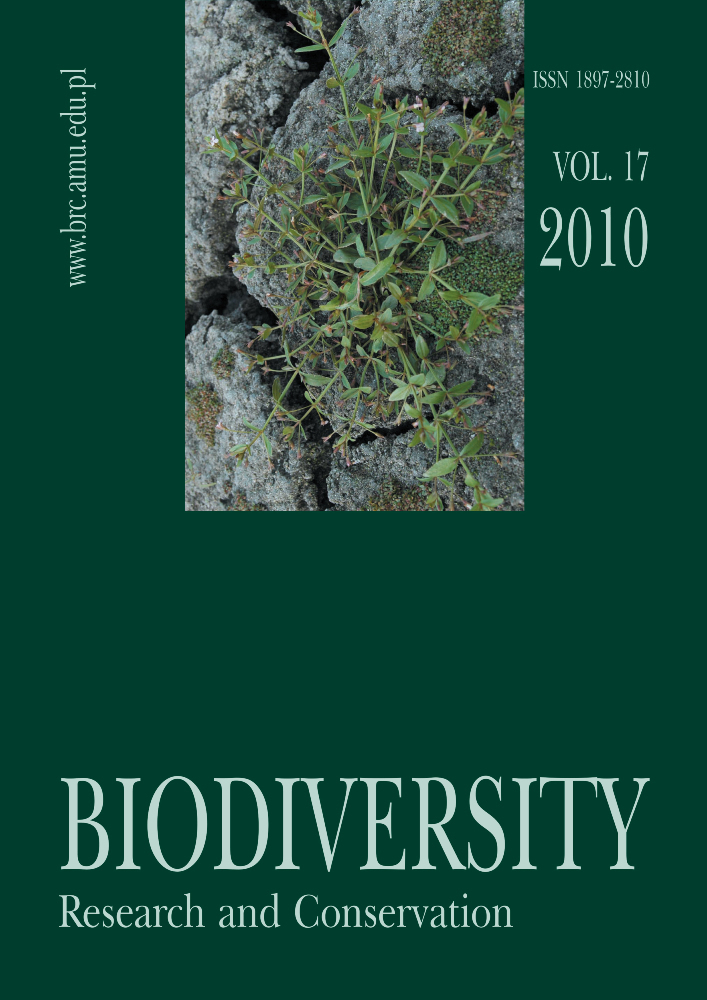Abstract
New data regarding the occurrence of Lindernia procumbens (prostrate false pimpernel) are discussed and its current geographical range in Poland is given. A comparison of its past and present distribution in Poland indicates an advancement of the distribution limit northwards, which may be caused by climate changes, mostly, by an increased number of heat waves in the warm half-year. The relationship between the occurrence of the species and specific meteorological conditions, especially, unusually hot and dry summer periods, is analysed using long-term meteorological surveys.
References
Banaś B. & Paul W. 2000. Distribution of Lindernia procumbens (Scrophulariaceae) in the Polish Carpathians and their foreland. Fragm. Flor. Geobot. Polonica 7: 365-368.
Brázdil R., Budíková M., Auer I., Böhm R., Cegnar T., Faško P., Lapin M., Gajič-Čapka M., Zaninovič K., Koleva K., Niedźwiedź T., Ustrnul Z., Szalai S. & Weber R. O. 1996. Trends of maximum and minimum daily temperatures in central and south-eastern Europe. Int. J. Climatol. 16: 765-782.
Burkart M. 2001. River corridor plants (Stromtalpflanzen) in Central European lowland: a review of a poorly understood plant distribution pattern. Global Ecol. Biogeogr. 10: 449-468.
Domonkos P., Kysely J., Piotrowicz K., Petrovic P. & Likso T. 2003. Variability of extreme temperature events in South-Central Europe during the 20th century and its relationship with large-scale circulation. Int. J. Climatol. 23: 987-1010.
Holmgren P. K. & Holmgren N. H. 1998. [continuously updated]: Index Herbariorum: A global directory of public herbaria and associated staff. New York Botanical Garden's Virtual Herbarium. http://sweetgum.nybg.org/ih/
Holub J. & Procházka F. 2000. Red list of vascular plants of the Czech Republic - 2000. Preslia 72(2-4): 187-230.
Jasiewicz A. 1981. Wykaz gatunków rzadkich i zagrożonych flory polskiej. Fragm. Flor. Geobot. 27(3): 401-414.
Korneck D., Schnittler M. & Vollmer I. 1996. Rote Liste der Fern- und Blütenpflanzen (Pteridophyta et Spermatophyta) Deutschlands. Schr.-R. f. Vegetationskde 28: 21-187.
Kożuchowski K., Trepińska J. & Wibig J. 1994. The air temperature in Cracow from 1826 to 1990: persistence, fluctuations and the urban effect. Int. J. Climatol. 14: 1035-1049.
Kuchcik M. 2006. Heat waves in Poland over the period 1993-2002. Przegl. Geogr. 78(3): 397-412.
Lampe M. 1996. Wuchsform, Wuchsrhythmus und Verbreitung der Arten der Zwergbinsengesellschaften. Diss. Bot. 266: 1-355.
Latowski K., Zając M. & Zając A. 1988. Lindernia procumbens (Krock.) Philcox. In: A. Jasiewicz (ed.). Materials for knowledge of rare and endangered species of Poland. Part I. Fragm. Flor. Geobot. 33: 416-421.
Meusel H., Jäger E., Rauschert S. & Weinert E. 1978. Vergleichende Chorologie der zentraleuropäischen Flora. II. Text xi? pp., Karten pp. 259-421. Gustav Fischer Verlag, Jena.
Niklfeld H. & Schratt-Ehrendorfer L. 1999. Rote Liste gefärdeter Fern- und Blütenpflanzen (Pteridophyta et Spermatophyta) Österreichs. In: H. Niklfeld (ed.). Rote Listen gefährdeter Pflanzen Österreichs, pp. 33-130. Austria Medien Service GmbH, Graz.
Niedźwiedź T. & Twardosz R. 2004. Long-term variability of precipitation at selected stations in Central Europe. Papers on Global Change IGBP 11: 1-28.
Pampuch A. 1940. Flora Tremesnensis, pp. 70. Verl. von G. Olawski, Trzemeszno.
Piotrowicz K. 2003. Dynamika zmian temperatury powietrza w Pradze i Krakowie. In: J. Lach (ed.). Dynamika zmian środowiska geograficznego, pp. 96-104. Narod. Fundusz Ochr. Środ. i Gosp. Wodnej, Akad. Pedag., Kraków.
Piotrowicz K. & Wypych A. 2006. Long-term variations in the number of hot, very hot and sultry days in Kraków. Papers on Global Change IGBP 13: 43-58.
Popiela A. 1997. Occurrence of the Isoëto-Nanojuncetea-class communities in Poland. Monogr. Bot. 80: 1-59.
Popiela A. & Stasińska M. 1994. New locality of Lindernia procumbens (Scrophulariaceae) in the basin of the Barycz River. Fragm. Flor. Geobot. Polonica 1: 350-352.
Procházka F., Husák Š. & Oťaheľová H. 1999. Lindernia procumbens (Krocker) Philcox. In: J. Čeřovský, V. Feráková, J. Holub, Š. Maglocký & F. Procházka (eds). Červená kniha ohrozených a vzácnych druhov rastlín a živočíchov SR a ČR, Vyššie rastliny, Vol. 5, pp. 225-225. Príroda a. s., Bratislava.
Spałek K. 2006. Lindernia procumbens (Krocker) Philcox in SW Poland. Thaiszia J. Bot. 16: 51-57.
Strech A. 1941. Lindernia pyxidaria in der Mark Brandenburg. Verh. Bot. Ver. Berlin Brandenburg 81: 165-167.
Twardosz R. 1999. Warunki pluwialne w Krakowie w latach 1792-1998. Czas. Geogr. 70(2): 221-234.
Wayda M. 1996. New locality of Lindernia procumbens (Scrophulariaceae) in the Sandomierz Basin. Fragm. Flor. Geobot. Polonica 3: 401-402.
Young Son C. & Rutto K. L. 2002. Are Herbicides Essential for Paddy Weed-control in East Asia? Pakistan J. Biol. Agric. Sci. 5(12): 1352-1362.
Zając A. 1978. Atlas of distribution of vascular plants in Poland. Taxon 27(5-6): 481-484.
Zając M. & Zając A. 1988. Communities of Isoëto-Nanojuncetea-class at the bottom of drying up ponds in southern part of Kotlina Oświęcimska valley. Zesz. Nauk. UJ Prace Bot. 17: 155-160.
Zając M., Zając A. 2001. Lindernia procumbens (Krocker) Philcox. In: R. Kaźmierczakowa & K. Zarzycki (eds). Polish Red Data Book of Plants, Pteridophytes and Flowering Plants, pp. 322-324. W. Szafer Institute of Botany & Institute of Nature Conservation PAN, Kraków.
Zarzycki K. 1986. Lista wymierających i zagrożonych roślin naczyniowych w Polsce. In: K. Zarzycki & W. Wojewoda (eds.). Lista wymierających i zagrożonych roślin naczyniowych Polski, pp. 11-27. PWN, Warszawa.
Zarzycki K. & Szeląg Z. 2006. Red list of the vascular plants in Poland. In: Z. Mirek, K. Zarzycki, W. Wojewoda & Z. Szeląg (eds.). Red list of plants and fungi in Poland, pp. 9-20. W. Szafer Institute of Botany, Polish Academy of Sciences, Kraków.
Zarzycki K., Trzcińska-Tacik H., Różański W., Szeląg Z., Wołek J. & Korzeniak U. 2002. Ecological indicator values of vascular plants of Poland. In: Z. Mirek (ed.). Biodiversity of Poland 2, 183 pp. W. Szafer Institute of Botany, Polish Academy of Sciences, Kraków.




